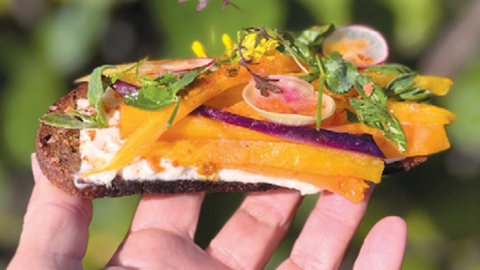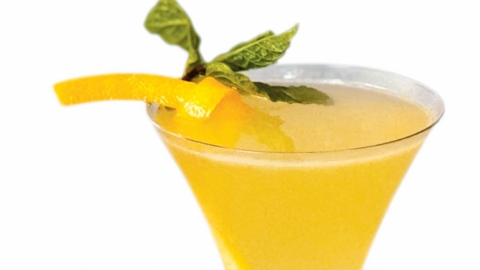Where the Bees Are
Bees, whether European or native, need care and forage. Beekeepers, finely tuned to bees’ needs, provide human guidance throughout the year, helping the winged creatures move safely into a new home or manage their food supply. Looking after honey makers involves a fine balance of knowing when to step in and when to step back. And the help of the local community.
I spent time with three local beekeepers, learning about their high season, honey as a by-product of the work, and the importance of native, winter-blooming plants.
Bonnie Bee Co.: Bee Seasons to Match Forage Seasons
San Rafael residents Bonnie and Gary Morse did not intend to become beekeepers. After semi-retiring from a wholesale business (Gary) and a career as an arborist/horticulturist (Bonnie), they were drawn into the lifestyle by watching a neighbor manage his hives. Their so-called “rookie mistake”—attempting to start a hive in April—led them deep into what became their retirement project: beekeeping consulting and education.
The Morses manage hives around Marin, from Mill Valley and San Rafael to Bolinas and Point Reyes Station, working with individuals and businesses on everything from catching swarms and sourcing bees to how to manage hive populations to endure winter and thrive in our unique Mediterranean climate.
“My theory?” Bonnie says. “Bees have been around 120 million years, largely unchanged, versus our 100,000. We are here to do their bidding.”
In classes at Point Reyes Station’s Heidrun Meadery, in San Rafael, and in backyards and fields around Marin, Gary and Bonnie support beekeepers with varying levels of experience at animal husbandry. First up is understanding the bees’ seasons and the importance of winter-blooming forage. Bonnie notes that most comb-building in our area is the bees’ work from February until May or early June. Our rains typically stop at that time and we transition to a dry summer, with little native forage for bees who have evolved with this climate. That’s not a problem for local bees, who “have dug their holes and are pupating in the soil until the next season,” Bonnie says.
To keep our native pollinators fed and happy during their busiest season of reproducing and building their homes, Bonnie suggests planting native plants that bloom as early as February, when our local bees are at their busiest. “Ceanothus,” she says, and—although it is on the California Invasive Plant Council’s list—echium. “If we did not have echium, we would probably have difficulty keeping native bees, as there is not enough for the bees to eat as the season begins,” Bonnie says.
If you are considering putting in a pollinator garden or transitioning a lawn (a virtual dead space for most fauna), Bonnie recommends 70% native plants to not only maintain biodiversity but to support the bees. “Our hills used to be covered with lupine and poppies during spring,” she says. And if you want your own hives for honey? “Talk to a beekeeper before you get started,” Bonnie says. The Marin Beekeepers Association can help.
Rob Keller: A Sense of Wonder About Bees (in Trees)
Is there such a thing as a bee whisperer? If so, Rob Keller may be one. The UC Davis MFA and member of the inaugural class of UC Davis’s Master Beekeeper Program fell in love with bees while studying Egyptology and mummification.
“It’s my life’s calling,” Keller says. On a recent journey around Napa, where Keller keeps or tends many hives, we stopped at his Carneros farm. There, bees are housed in everything from old wine barrels to traditional Warré hives. A row of log hives caught my eye. Was this a new trend? No. “Bees have always lived in vertical configurations like a tree,” Keller says.
Keller encouraged me to remove a “window,” a square cut into the log’s bark, an opportunity to peer inside the colony’s home and check on their health. This particular log was a rescue from an arborist but Keller keeps bees in log hives and Langstroth hives—the popular stacks of boxes widely used in apiaries around the United States—and educates using both. A natural teacher, he works with St. Helena Montessori, educating students to what he calls “the beauty and the wonder of the natural world.”
Though he is hesitant to refer to his work as regenerative beekeeping, noting that there is no fixed standard for that term in animal husbandry, Keller and others manage bees’ nutrition, breeding and day-to-day care with a focus on ecosystem health. The health of the bees and the community in which they live, work and reproduce is job one. He prefers the term Darwinian beekeeping, or prioritizing bee health over honey production.
Bees living in logs instead of Langstroth hives? That’s Darwinian. It’s much harder to pull honey from a log than a frame inside a Langstroth. But more natural for ecological restoration.
Keller’s passion for teaching took us to Carneros Resort & Spa, where Keller keeps log hives and Langstroths, some inside what he calls a Bee Cottage. One of just a few apitherapy huts in the United States (there are others in Georgia and Michigan and many in Europe, especially Germany) the roughly six-foot-square, custom-built tiny house is part of the resort’s Bee Experience in which guests are invited to lie in a protected space above two active colonies to bathe in the sound, energy and aromatherapy benefits of what can only be called bee air. While the health benefits of bee air are (endlessly) discussed by professionals, most cottage guests emerge with a feeling of calm.
Keller notes the positive human shift in bee interactions. “It’s not about having a lot of bees anymore—you really need the bandwidth and lifestyle for keeping bees,” he says. And a Bee Cottage is part of Keller’s wish to creating wonder about the bees. “They’re our bees,” he says, referring to our role in supporting the essential but imperiled species. “Not yours. Not mine. Ours.”
Sonoma County Bee Co.: The Magic of Swarms and Honey Crush
Candice Koseba, owner of Sonoma County Bee Co., has a problem with calling beekeeping a hobby. “We need to change that,” she says. Beekeeping is a skill you have to learn, one with a task list. “Unlike basketball or knitting or wood-working, you can’t just pick it up and put it down.” Koseba prefers the term sideliners for those who may have another job or don’t make bees their full-time job.
Bees, like other animals, behave in different ways as the year moves along. Activities happen within seasons. Swarming is typical for spring (which starts in February in our part of California), when bees are reproducing, looking for new homes, and storing honey for winter. Bees, which are biologically inclined to swarm, leave the hive with the queen. (Inside the hive, they’ll make a new queen.) Spring is high season for beekeepers.
Koseba, like the other apiarists I spoke with, captures and rehomes swarms as a service to the public. If you spot a swarm, she suggests reaching out to the Sonoma County Beekeepers Association to find the contact for your area. “We all have our phones on in the spring,” she says, noting that most swarms are handled within 30 minutes.
Swarms are not something to be afraid of, as there is no brood or honey to protect. A bee swarm is not aggressive. “They’re just trying to find a new home and start building comb,” Koseba says. While it is not for the faint of heart or the allergic, Koseba suggests trying to stand in a swarm cloud. “It gives you chills. It’s really calming,” she says.
After the honey harvesting months of August, September and October, come the quieter beekeeping months of November, December and January, when Koseba spends more time at her sugar shack at the entrance to Preston Farm and Winery on Dry Creek. Inside, she hand-crushes honeycomb with honey, letting the honey pass over the propolis and pollen, a process that keeps the natural enzymes and minerals intact.
A graduate of the California School of Herbal Studies and life-long maker, Koseba turns each year’s honey crush into Herb Salve infused with chickweed and plantain leaf, and Vitamin Herbal Honey pinked with hibiscus and rose hip. “I support bees through the product line, not through honey,” she says. “I don’t want the bees to be a commodity.” Look for her beeswax candles, vitamin honey, propolis immune tonic and other products at La Ruche in Healdsburg and at holiday markets and boutique shops in Sonoma.
Honey Inspiration
Chefs, makers and small business owners find inspiration in our local honey. Here’s how they’re using it:
Scandinavian Toast with Confit Carrots
Farmstead, St. Helena
Chef Kipp Ramsey coaxes out carrots’ natural sweetness by poaching them in a gentle clarified beeswax bath. The carrots are then bias cut, layered over a slice of Model Bakery’s crisped Sebastopol Field Blend, spread with honey-infused Bellwether ricotta and topped with garden greens. The toasts carry the gentle aroma of beeswax and the flavor of spring. Adapted recipe on facing page. LongMeadowRanch.com
Bitter Girl Bitters
Petaluma
The bar manager at Kentfield’s Guesthouse and Corte Madera’s Mijo Marin, Erin Elizabeth Hines makes bitters with aromatics sourced from her garden. With honey from Buddy’s Farm in Petaluma, Garden Party features chocolate mint and lavender and tastes of summer. “The honey is a standout in this flavor as it is one of just three components,” Hines says. Cocktail recipe facing page. BitterGirlBitters.com
Honey-Glazed Pain de Miel
Auro, Calistoga
When Chef Rogelio Garcia serves this pillowy-soft honey bread at Auro in Calistoga it’s in the form of individually sized clover rolls sticky with honey from nearby Marshall Farms. Served with artisanal butters and sprinkled with black and white sesame seeds, the buns are a simple and striking standout when they appear on the tasting menu. Braided loaves recipe facing page. AuroNapaValley.com
La Ruche
Healdsburg
La Ruche—the beehive in French—opened in mid-December, a honey and mead tasting bar dedicated to products of the hive. Owner Nicole White offers tastings of locally and globally sourced honeys, as well as mead, jam, candies and many other items, some non-edible. “The whole concept of the store is ”Every honey tells a story,’” White says. LaRucheHealdsburg.com
Heidrun Meadery
Point Reyes Station
Heidrun’s sparkling mead offers a lightly fermented interpretation of each of the honeys from which it is crafted. The meadery sources honey from around the world (including right here in the North Bay) and brews fresh flavors with each new season. Visitors love the Point Reyes tasting venue and popular Bee-Experience Tour which covers every step of the meadmaking process—from honey gathering to distillation to glass. HeidrunMeadery.com
Marshall Farms
American Canyon
Marshall Farms has been harvesting honey from hives throughout the Bay Area for more than 33 years. They offer a range of location- and blossom-specific honeys and related products such as beeswax, bee pollen, candles and honey-comb. Honeycomb is available by the full frame, in jars, or plastic clamshells. The full frames make a captivating addition to a charcuterie board, cheese tray or dessert table. MarshallsHoney.com

























